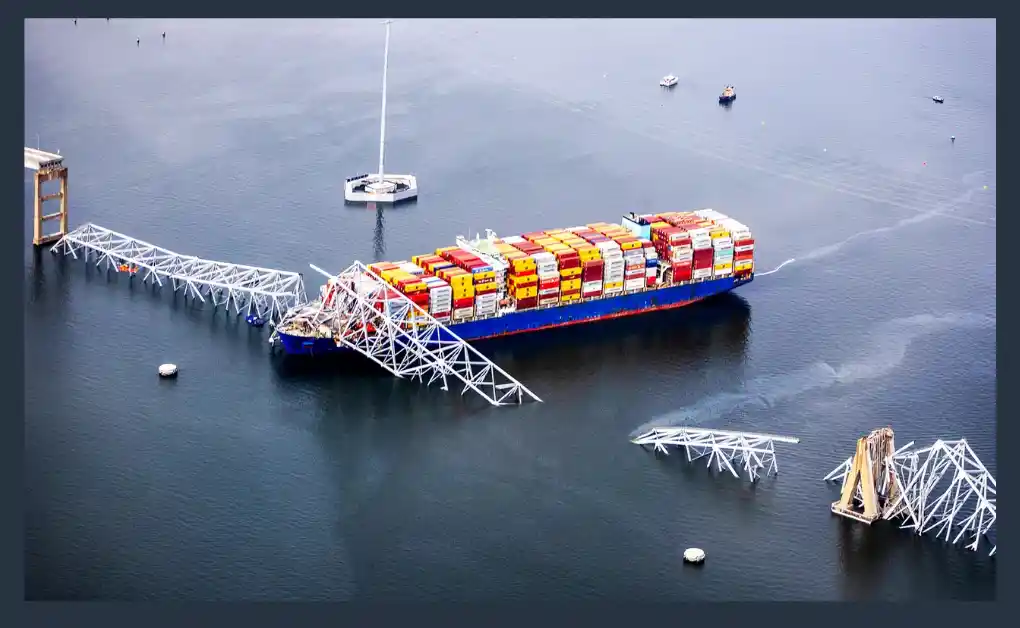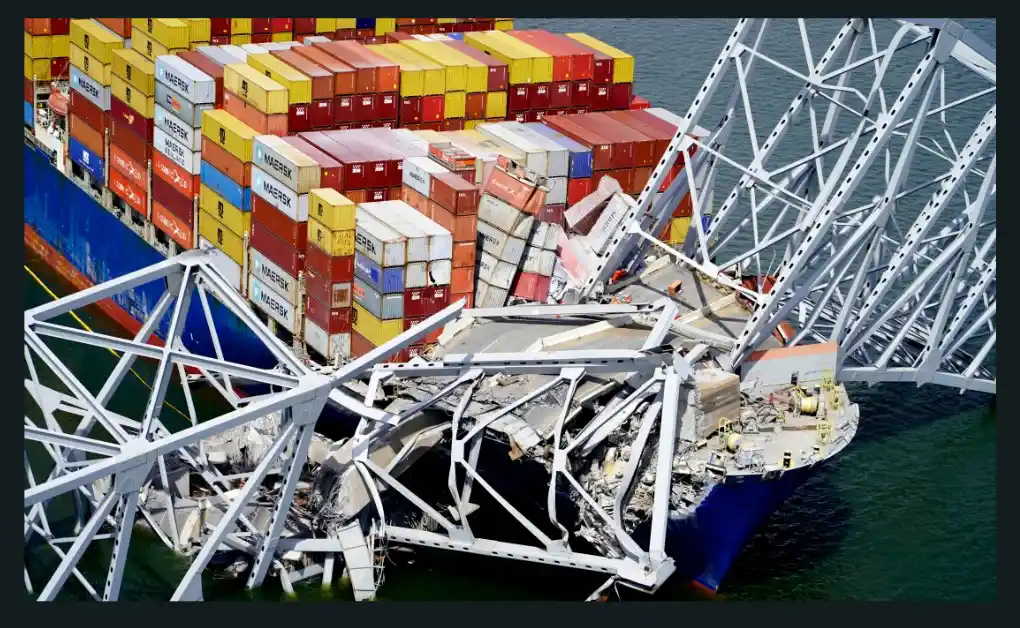The U.S. Department of Justice has filed a lawsuit against the owner and operator of the container ship Dali, seeking $100 million in damages for the devastating collapse of the Francis Scott Key Bridge in Baltimore. The incident occurred in March when the Dali crashed into the bridge, causing massive destruction and loss of life.

The Tragic Collapse of the Francis Scott Key Bridge in Baltimore
The crash led to the collapse of the Francis Scott Key Bridge in Baltimore, killing six construction workers and shutting down a vital port for months. The incident also destroyed a portion of Interstate 695, which runs over the bridge. The U.S. government claims that the disaster was “entirely avoidable” and is holding the ship’s owner and operator accountable for their negligence.
Government Blames Cost-Cutting for the Baltimore Bridge Collapse
According to the lawsuit, Grace Ocean Private Limited and Synergy Marine Private Limited, both Singapore-based companies, were responsible for putting profits over safety. The Department of Justice alleges that the companies sent the Dali, an “unseaworthy vessel,” with an ill-prepared crew to navigate U.S. waters. The lawsuit emphasizes that the costs associated with the emergency response to the Baltimore bridge collapse should not fall on American taxpayers but instead, be borne by the companies involved.
What Led to the Francis Scott Key Bridge Baltimore Tragedy?
The crash of the Dali in Baltimore was not just a freak accident. Court documents reveal a series of failures that led to the catastrophic collapse of the bridge. As the ship approached the Francis Scott Key Bridge, its number 1 step-down transformer failed, cutting power to the ship’s systems. The power loss made it impossible for the crew to steer the vessel, causing it to drift toward the bridge. Although the ship had a backup transformer, the system that would automatically switch to it had been disabled, leaving the crew struggling to manually reset it in the dark.
A Sequence of Failures Leads to a Deadly Ship and Bridge Disaster
The lawsuit explains how various safety measures failed in critical moments. After the transformer failure, none of the ship’s systems—including the propeller, rudder, anchor, or bow thruster—were functional when they were needed most to avoid the bridge. Under maritime regulations, a container ship like the Dali must be able to access emergency power within 45 seconds of a blackout. However, the Dali drifted without power for well over a minute, during which time the crew’s attempts to regain control failed.

Cost-Cutting Decisions That Caused the Baltimore Bridge Collapse
The U.S. government alleges that decisions made by the ship’s operators to cut costs contributed significantly to the Scott Key Bridge collapse. Instead of using a standard fuel pump to supply the diesel generators, they opted for a “flushing” pump, which lacked the ability to restart automatically after a power outage. This meant the main engine and propeller were never restored, leaving the ship powerless as it approached the Francis Scott Key Bridge in Baltimore.
Desperate Attempts to Avoid the Baltimore Bridge Fall
As the situation escalated, the pilot on board the Dali made desperate attempts to avoid a collision. Orders were given to drop the anchor to steer the ship away from the bridge, but the anchor was not ready to be deployed in time. When it finally dropped, it was too late to make any difference. An attempt to use a bow thruster to turn the ship away from the bridge was also unsuccessful, as the thruster was marked “unavailable” in the ship’s log.
The Collapse and the Aftermath of the Francis Scott Key Bridge
The Dali eventually slammed into a support pier, causing significant sections of the Francis Scott Key Bridge to collapse into the Patapsco River and onto the ship. The Baltimore bridge collapse not only resulted in the loss of six lives but also created a logistical nightmare, shutting down a busy port and a major highway. The wreck left behind roughly 50,000 tons of debris, including steel and other materials, which had to be cleared to create a temporary channel for other ships.
Maryland to Pursue Separate Compensation for Rebuilding the Bridge
The federal lawsuit seeks $100 million to cover costs associated with the emergency response, debris removal, and temporary fixes to maintain some level of port access. However, the rebuilding of the bridge itself will be a separate matter, with the state of Maryland pursuing its own compensation.
Seeking Justice for the Francis Scott Key Bridge Baltimore Collapse
Attorney General Merrick B. Garland stated that the Justice Department is committed to holding the companies accountable for the bridge fall, ensuring that they, not American taxpayers, pay for the damage caused. The government aims to prove that the Dali operators ignored the risks and made dangerous cost-cutting decisions that led to the tragic ship and bridge disaster.
The Legal Battle Over the Baltimore Bridge Collapse
The ship’s owner and operator have attempted to cap their liability at less than $44 million, but the U.S. government is challenging this, stating that the companies’ negligence caused far more extensive damages. As the legal proceedings unfold, the Francis Scott Key Bridge Baltimore disaster serves as a stark reminder of the consequences of prioritizing cost savings over safety in maritime operations.
FAQs
What caused the Baltimore bridge collapse?
The Baltimore bridge collapse occurred after the container ship Dali lost power and collided with the Francis Scott Key Bridge, causing a section to collapse.
Who is being sued over the Scott Key Bridge collapse?
The U.S. Department of Justice is suing Grace Ocean Private Limited and Synergy Marine Private Limited, alleging negligence and cost-cutting measures contributed to the disaster.
How did the Dali ship lose power?
The ship lost power due to a failure in the number 1 step-down transformer, compounded by the disabling of an automatic backup system and a decision to use a non-standard fuel pump.
What were the consequences of the bridge fall?
The collapse led to six fatalities, extensive damage to Interstate 695, months of traffic disruption, and significant costs for emergency response and debris removal.
What steps are being taken to prevent future incidents like the Francis Scott Key Bridge collapse?
The lawsuit seeks to enforce accountability for safety violations and may lead to stricter maritime regulations to ensure vessels are properly maintained and prepared for emergencies.